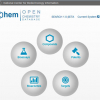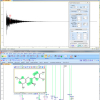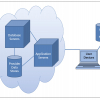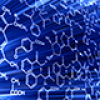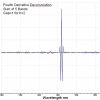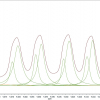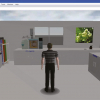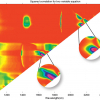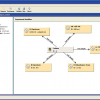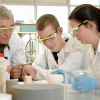Antony N. Daviesa,b and Robert Lancashirec
aSERC, Sustainable Environment Research Centre, Faculty of Health, Sport and Science, University of Glamorgan, UK
bAkzo Nobel Chemicals bv, Deventer, The Netherlands
cUniversity of the West Indies, Mona Campus, Kingston, Jamaica
Introduction
Bob McDonald, co-author with Paul Wilks of the first JCAMP-DX standard for infrared spectroscopy, sadly passed away recently following a short illness.1
Bob was born on 19 July 1918 in Pittsburgh, Pennsylvania, USA, and grew up in Portland, Maine, and gained a PhD in Physical Chemistry from MIT after the war. Bob was an industrial spectroscopist and spent most of his working life with the Corporate Research and Development Center, General Electric Company at Schenectady near New York, working on materials characterisation mainly by infrared spectroscopy until his retirement in 1983.
Bob was one of the pioneers in infrared spectroscopy—graduating from the University of Maine in Engineering Physics at the start of the Second World War, Bob went to work at the Stamford Research Laboratories of the American Cyanamid Company and was involved with the development of one of the first commercial infrared spectrometers, the Perkin-Elmer Model 12. The development of what became the Model 12 was driven by the need for synthetic rubber during World War II as the Japanese invasion of the Dutch East Indies and Malaya had stopped the supply of natural rubber. America’s small natural rubber stockpile and recycling programmes were completely inadequate to meet the increased war-time demand, and the Roosevelt government formed the Office of Rubber Reserve tasked with producing large quantities of synthetic rubber. 1940’s synthetic rubber was formed from polymerising butadiene, supplied by petroleum companies. With the supply of the raw material organised, the Office of Rubber Reserve needed to procure an analytical method capable of determining the concentration and purity of butadiene at every step of the rubber synthesis and to quantitatively follow the styrene–butadiene reaction that yielded the natural rubber substitute. Fortunately, Bob had joined one of the few companies in American Cyanamid which had realised the potential importance of infrared spectroscopy. One key aspect of their work was to be the location of a supply of high-purity natural sodium chloride crystals from the Soviet Union to replace the natural rock salt which suffered from impurities. The first delivery arrived in New York immediately before the start of World War Two and the ship delivering the cargo was in great haste to return to its home port as soon as possible. It was the last Soviet ship to leave New York before the outbreak of the war in Europe.2 Bob was personally involved in the manufacturing of these ground-breaking instruments and had reminisced about the highly technical nature of the developments of the key optical components—“…sawing a prism blank from one of the larger pieces with a wet string saw”!

At this stage in the development of infrared spectroscopy, the speed of instrumentation development and the capabilities of the instruments were very much limited by the available optics. Reproducible gratings did not arrive until after the war. The team at Cyanamid worked closely with the nearby Perkin-Elmer company which had been originally established to manufacture high grade optics for astronomical applications and had some excellent optical technicians on their staff. American Cyanamid exploited their expertise in manufacturing optical components producing a prototype single-beam instrument which was sent to the Rubber Reserve and four more instruments, three of which went out-of-house, one to Gulf Research labs, one to General Electric for studying silicones and one to Perkin-Elmer to be used as the prototype for future instruments. The Cyanamid design used a novel off-axis paraboloid as a collimator which was first delivered to Cyanamid shortly before a public holiday. Paul Wilks has noted that Bob installed the new optics over the break and had the first spectra from the new prototype, considerably out performing their original large table-sized IR spectrometer, to proudly show the team when they returned to work following the holiday.3 Paul himself was involved in assembling and aligning the first 25-instrument batch of the Perkin-Elmer 12A IR spectrometer which Richard Perkin expected to completely saturate the market—by the time the first 25 were shipped they had a backlog of 65 more orders!
Not only did Bob work in the teams pioneering instrumentation, but also the sampling and sample preparation steps. It is possible that in 1942 he was the first to prepare a sample using the Nujol mull technique when R. Bowling Barnes, the team leader at American Cyanamid, suggested that using a technique from paint manufacturing of grinding slurry between two 6–8 inch glass plates might be of use in preparing some phthalocyanine samples submitted to their laboratory for analysis. This Bob then did with great success, refining the technique to handle smaller sample amounts more appropriate for the infrared instrumentation.
Whilst at General Electric Bob published a series of review articles in Analytical Chemistry which are worth going back and reading in their own right as a clear chronicle of the development of industrial and academic applications in infrared spectrometry as it became the popular simple analytical tool it is today. His interest in exploiting computers also extended to solving his reviewing task by developing his own bibliographic system which he called LISE (LIterature Search and Edit) handling the then fledgling Chemical Abstracts Condensates (CAC) database being distributed on 7-track magnetic tape.4 Bob observed in 1972 the encroachment of techniques such as such as nuclear magnetic resonance spectrometry, gas chromatography and mass spectrometry moving into areas once dominated by infrared spectrometry and again in 1974 with the coming of the hyphenated techniques.5 Bob’s reviews continued for more than a decade initially documenting and commenting on the technical aspects of the development of infrared spectrometry such as detector technology, the introduction and increasing dominance of Fourier transform instrumentation through to hyphenating the technique. Bob was honoured by an invitation to join the advisory board of Analytical Chemistry in 1979 and his reviews go over more and more to looking at the ever broadening application of infrared spectroscopy to many new areas such medical/pharmaceutical, toxicology, online and environmental applications, microscopy and trace gas analysis, as well as developing further in the fields of polymer analysis (where it all started!). This trend he himself recognised and commented on as the maturing of the technique. By 1984 he flagged the rapid development of applications of near infrared spectroscopy for the analysis of agricultural products as “spectacular”, taking care to point out the broad band overlap would cause a normal spectroscopist to believe that the technique could never work—but that comparison of the quantitative data is comparable to the chemical methods used to establish the standards whilst the near infrared method was much easier and faster.

I only got to know Bob after his retirement when he very actively pursued his interest in the power of computing to support spectroscopy. As has been discussed many times in this column it was his ground-breaking work with Paul Wilks and the instrument vendors on the JCAMP-DX standard for infrared spectroscopy that pioneered the concept of the free exchange of data between different manufacturers and third-party software houses, many years before the concept of the world-wide web caught on!6 Fortunately for us, Bob’s approach of keeping the standard simple and character-based, and always insisting that the standard should be freely available and accessible to all has ensured its longevity and robustness compared to alternative developments exploiting various short-term IT trends. Bob also made a point of following good practise by releasing code in several computer languages capable of reading and writing JCAMP-DX files for all developers to test against. Bob enjoyed strong vocal support through the presence of the Society for Applied Spectroscopy representatives in the JCAMP organisation whose enthusiasm ensured wide-spread distribution of the standards through publication in Applied Spectroscopy.
He received the Emeritus award from the Society of Applied Spectroscopy in 2010 for his tireless dedication to the field.
He could be very stubborn in holding on to his vision but the core decisions he and Paul Wilks took in developing the original JCAMP-DX protocol worked well in quite different spectroscopy fields such as multi-dimensional NMR. He constantly strove for simplicity as the key to longevity and I believe frowned on many of the more recent developments as being too complex to survive long-term. How many computer files can you read today that were first created 24 years ago! Many of the files he published on his web site promoting JCAMP-DX are still available from the JCAMP-DX.org site or from the Chemistry Department web site at UWI, Mona in Jamaica.
We will miss him.
References
- Obituary published in The Daily Gazette, Schenectady, NY, USA, 26 March 2012.
- F.A. Miller, “Reminiscences of pioneers and early commercial IR instruments”, Anal. Chem. 64(17), 824A–831A (1992). doi: 10.1021/ac00041a718
- P.A. Wilks, “The evolution of commercial IR spectrometers and the people who made it happen”, Anal. Chem. 64(17), 833A–838A (1992). doi: 10.1021/ac00041a724
- R.S. McDonald, “Infrared spectrometry”, Anal. Chem. 44(5), 241R–250R (1972). doi: 10.1021/ac60313a025
- R.S. McDonald, “Infrared spectrometry”, Anal. Chem. 46(5), 521R–543R (1974). doi: 10.1021/ac60341a010
- R.S. McDonald and P.A. Wilks Jr, “JCAMP-DX: A standard form for exchange of infrared spectra in computer readable form”, Appl. Spectrosc. 42, 151 (1988). doi: 10.1366/0003702884428734



